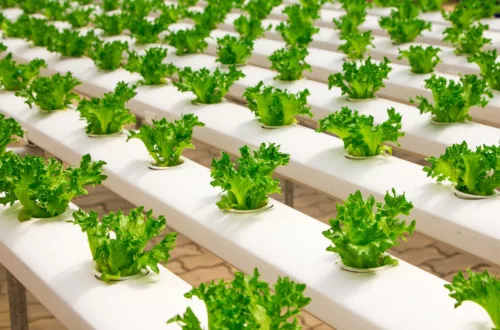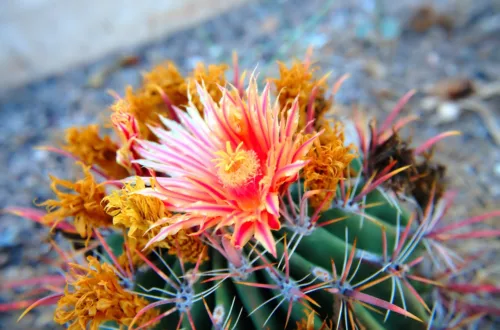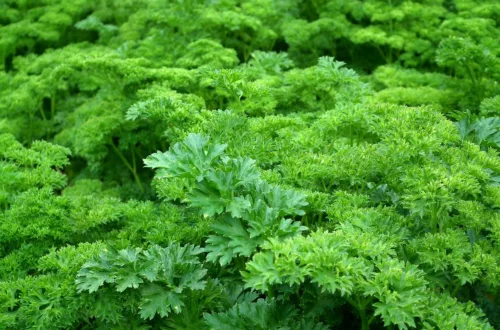Are you interested in growing your own herbs? Well, you’re in luck! In this article, we’ll be discussing the fastest growing herbs that you can easily grow in your garden or even indoors. Growing your own herbs not only saves you money, but it also ensures that you have fresh herbs on hand whenever you need them.
Whether you’re an experienced gardener or a beginner, growing herbs is a great way to add flavor to your meals and enhance your overall well-being. Some of the fastest growing herbs include basil, cilantro, and parsley. These herbs are not only easy to grow, but they also have a wide range of health benefits. For example, basil is known for its anti-inflammatory properties, while cilantro is rich in antioxidants and can help improve digestion.
So, if you’re looking to add some fresh, flavorful herbs to your kitchen, keep reading! We’ll be sharing tips on how to grow the fastest growing herbs and how to use them in your cooking. With a little bit of effort, you can have a thriving herb garden in no time.
Getting Started with Herb Gardening
If you are interested in growing your own herbs, you have come to the right place! Herb gardening is a fun and rewarding activity that can be done in any size space, from a small balcony to a large backyard. In this section, we will cover the basics of getting started with herb gardening.
Choosing the Right Herbs~ Fastest Growing Herbs
The first step in herb gardening is choosing which herbs you want to grow. There are many different herbs to choose from, each with their own unique flavor and growing requirements. Some of the fastest growing herbs include basil, cilantro, and parsley. These herbs can be grown from seeds or purchased as seedlings from your local nursery.
When choosing herbs, consider which ones you will actually use in your cooking. If you love Italian food, you might want to grow basil, oregano, and thyme. If you enjoy making tea, you might want to grow chamomile, mint, and lemon balm. Make sure to choose herbs that will thrive in your climate and growing conditions.
Understanding the Growing Season~ Fastest Growing Herbs
Herbs are typically grown in the spring and summer months, when the weather is warm and sunny. Most herbs prefer full sun, which means they need at least six hours of direct sunlight each day. Some herbs, such as mint and parsley, can tolerate partial shade.
The growing season for herbs varies depending on the plant. Some herbs, such as basil and cilantro, grow quickly and can be harvested within a few weeks of planting. Other herbs, such as rosemary and thyme, take longer to mature and may not be ready to harvest for several months.
Essential Supplies for Herb Gardening~ Fastest Growing Herbs
To get started with herb gardening, you will need a few essential supplies. These include:
- Herb seeds or seedlings
- Well-draining soil
- Planting containers or a garden bed
- Fertilizer
- Watering can or hose
Make sure to choose a well-draining soil mix specifically designed for herb gardening. This will help prevent overwatering and root rot. If you are growing herbs in containers, make sure they have drainage holes in the bottom.
In conclusion, getting started with herb gardening is easy and fun. Choose the right herbs for your growing conditions, understand the growing season, and gather the essential supplies. With a little bit of care and attention, you can grow your own herbs and enjoy fresh, flavorful ingredients in your cooking.
Fast-Growing Herbs to Plant
When it comes to fresh herbs, nothing beats the taste of just-picked leaves. Luckily, there are several fast-growing herbs that can be harvested early in the season. Here are our top picks for quick-growing culinary herbs.
Basil: The Quick Harvest~ Fastest Growing Herbs
Basil is one of the fastest-growing herbs, with some varieties maturing in as little as 30 days. It’s best to start basil indoors in early spring, then transplant it outdoors once the weather warms up. Basil loves warm, sunny weather and needs well-draining soil. Pinch off the tips of the plant regularly to encourage bushy growth, and harvest the leaves as soon as they are large enough to use.
Parsley: From Seed to Salad~ Fastest Growing Herbs
Parsley is another fast-growing herb that can be harvested early in the season. It takes about 70 days for parsley to mature from seed, so start it indoors in early spring. Parsley prefers partial shade and moist, well-draining soil. Once the plants are established, you can harvest the leaves as needed for salads, soups, and other dishes.
Cilantro: Rapid Growth Herb~ Fastest Growing Herbs
Cilantro is a rapid growth herb that can be harvested in as little as three weeks after planting. It’s best to sow cilantro seeds directly in the ground in early spring, as the plants don’t transplant well. Cilantro prefers cool weather and partial shade, and needs well-draining soil. Harvest the leaves as soon as they are large enough to use, as cilantro tends to bolt quickly in warm weather.
By planting these fast-growing herbs early in the season, you can enjoy fresh, flavorful leaves all summer long. Whether you’re adding them to salads, soups, or other dishes, these culinary herbs are sure to add a burst of flavor to your meals.
Caring for Your Herb Garden~ Fastest Growing Herbs
Growing herbs is a great way to add flavor and nutrition to your meals. Herbs are also easy to grow and maintain, making them a popular choice for both beginner and experienced gardeners. Here are some tips to help you care for your herb garden and ensure that your herbs grow strong and healthy.
Sunlight and Shade Requirements
Most herbs require full sun to grow properly. This means that they need at least six hours of direct sunlight per day. However, some herbs, such as mint and parsley, can tolerate partial shade. If you’re not sure how much sun your herbs need, check the seed packet or do a quick online search.
Watering and Drainage
Herbs need well-drained soil to thrive. Make sure your pots or garden beds have drainage holes to prevent water from pooling and drowning the roots. Water your herbs regularly, but be careful not to overwater them, as this can lead to root rot. A good rule of thumb is to water your herbs when the top inch of soil feels dry to the touch.
Dealing with Pests and Diseases
Pests and diseases can quickly destroy your herb garden if left unchecked. To prevent pests, keep your herbs healthy and well-watered. If you notice any signs of pests, such as chewed leaves or webbing, remove the affected leaves and spray your herbs with an organic pesticide. To prevent diseases, make sure your herbs have good air circulation and avoid overcrowding them.
By following these simple tips, you can ensure that your herb garden grows strong and healthy. Remember to keep an eye on your herbs for any signs of new growth, and don’t be afraid to experiment with different varieties and growing techniques. Happy gardening!
Indoor Herb Gardening Essentials
Growing herbs indoors is a great way to have fresh herbs available year-round. Not only do they add flavor to your meals, but they also have many health benefits. In this section, we’ll cover the essentials of indoor herb gardening.
Choosing the Best Indoor Herbs~ Fastest Growing Herbs
When it comes to choosing the best herbs to grow indoors, there are a few things to consider. First, you want to choose herbs that are well-suited for indoor growing. Some of the best herbs for indoor gardening include basil, chives, cilantro, mint, parsley, and thyme.
Second, consider the amount of light your herbs will need. Some herbs, like basil and parsley, require a lot of light, while others, like mint and thyme, can tolerate less light. If you have a south-facing window or a sunny windowsill, you’ll have plenty of light for your herbs. If not, you may need to invest in a grow light.
Setting Up an Indoor Herb Garden~ Fastest Growing Herbs
Once you’ve chosen your herbs, it’s time to set up your indoor herb garden. You can use pots or containers to grow your herbs, but make sure they have drainage holes to prevent overwatering. You can also use a variety of containers, such as mason jars, old tin cans, or even tea cups.
When planting your herbs, make sure to use a good quality potting mix. You can also add some compost or fertilizer to help your herbs grow. Water your herbs regularly, but be careful not to overwater them. Herbs like well-drained soil, so make sure your pots have drainage holes.
Grow Lights and Windowsills~ Fastest Growing Herbs
If you don’t have a south-facing window or a sunny windowsill, you may need to invest in a grow light. Grow lights are designed to provide the right amount of light for your herbs, and they come in a variety of sizes and styles.
When using a grow light, make sure to position it so that it’s about 6-12 inches above your herbs. You’ll also need to adjust the height of the light as your herbs grow.
In conclusion, growing your own herbs indoors is a fun and rewarding hobby. By following these indoor herb gardening essentials, you’ll be well on your way to having fresh herbs available year-round.
Perennial and Annual Herbs
When it comes to gardening, herbs are a popular choice. They add flavor to meals, have medicinal properties, and make great ornamental plants. Herbs can be categorized into three groups: perennials, annuals, and biennials. In this section, we will explore the differences between these three types of herbs.
Understanding Perennials
Perennial herbs are hardy plants that live for more than two years. They are a great addition to any garden because they come back year after year. Some examples of perennial herbs include rosemary, thyme, and sage. These herbs are perfect for those who want a low-maintenance garden. Perennial herbs are easy to care for and require minimal attention. They are also great for attracting pollinators to your garden.
Annuals: Yearly Delights
Annual herbs are plants that complete their life cycle in one year. They grow from seed, produce leaves, flowers, and seeds, and then die. Some examples of annual herbs include basil, cilantro, and dill. Annual herbs are perfect for those who want to add fresh flavors to their meals every year. They are also great for those who like to experiment with different herbs every year.
Biennials: Two-Year Treasures
Biennial herbs are plants that complete their life cycle in two years. In the first year, they grow leaves and roots. In the second year, they produce flowers and seeds before dying. Some examples of biennial herbs include parsley, caraway, and angelica. Biennial herbs are perfect for those who want to add a variety of herbs to their garden. They are also great for those who want to try something new every other year.
In conclusion, whether you choose a hardy perennial, an annual herb, or a biennial herb, herbs are a great addition to any garden. They are easy to care for, require minimal attention, and add fresh flavors to meals. Next year, consider adding some herbs to your garden and enjoy the many benefits they have to offer.
Harvesting and Using Your Herbs
Growing herbs is a rewarding experience, but the real payoff comes when we harvest and use them. In this section, we will discuss when and how to harvest your herbs, preserving fresh herbs, and the culinary and medicinal uses of herbs.
When and How to Harvest
When it comes to harvesting herbs, timing is everything. The best time to harvest your herbs is in the morning, after the dew has dried but before the sun gets too hot. This is when the essential oils are at their peak, giving your herbs the best flavor and aroma.
When harvesting, make sure to use clean, sharp scissors or pruning shears. Cut the stems just above a set of leaves, leaving enough of the plant intact to continue growing. For herbs with delicate leaves, like basil or cilantro, it’s best to pinch off the leaves by hand.
Preserving Your Fresh Herbs
Fresh herbs are a wonderful addition to any dish, but they can be difficult to store. Fortunately, there are several ways to preserve your fresh herbs for later use. One of the easiest ways is to freeze them. Simply chop up your herbs and place them in an ice cube tray with a little bit of water. Once frozen, you can pop the cubes out and store them in a freezer bag.
Another way to preserve your herbs is to dry them. Tie your herbs into small bundles and hang them upside down in a warm, dry place. Once dry, you can crumble the leaves and store them in an airtight container.
Herbs in Culinary and Medicinal Use
Herbs are incredibly versatile and can be used in a variety of ways. In the culinary world, herbs are used to add flavor and aroma to dishes. Fresh leaves are often used in salads, while dried leaves are used in soups, stews, and sauces. Some popular culinary herbs include basil, thyme, rosemary, and sage.
In addition to their culinary uses, many herbs are also used for their medicinal properties. Herbal tea, for example, is a popular way to enjoy the benefits of medicinal herbs. Chamomile tea is known for its calming properties, while peppermint tea can help soothe an upset stomach. Other popular medicinal herbs include echinacea, ginseng, and St. John’s Wort.
In conclusion, harvesting and using your herbs is an important part of the growing process. By following these tips, you can ensure that your herbs are at their peak when you harvest them, and that they stay fresh and flavorful for months to come.
Advanced Herb Gardening Techniques
Growing herbs can be a fun and rewarding experience, but it can also be challenging. We have found that using advanced herb gardening techniques can help us overcome some of these challenges and achieve faster growth rates. In this section, we will explore three advanced techniques that have proven to be effective.
Hydroponics: Soil-Free Herb Growing
Hydroponics is a soil-free method of growing plants that involves using nutrient-rich water as a growing medium. This technique has become increasingly popular in recent years due to its ability to produce fast-growing, high-yielding plants. Herbs are no exception! By using a hydroponic system, we have been able to grow herbs faster than we ever thought possible.
One of the biggest advantages of hydroponics is that it allows us to control every aspect of the growing environment. We can adjust the nutrient levels, pH, and temperature to create the perfect conditions for our herbs to thrive. This level of control also makes it easier to prevent pests and diseases from damaging our plants.
Creating Microclimates for Herbs
Another advanced technique we have found helpful is creating microclimates for our herbs. This involves creating small, controlled environments that are tailored to the specific needs of each herb. For example, some herbs prefer cooler temperatures, while others thrive in warmer conditions.
To create a microclimate, we use various techniques such as shading, windbreaks, and mulching. By creating the ideal growing conditions for each herb, we have been able to achieve faster growth rates and higher yields.
Breeding and Propagating Herbs
Breeding and propagating herbs is another advanced technique that can help us achieve faster growth rates. By selectively breeding plants with desirable traits, we can create new varieties that are better suited to our growing zone. This can include traits such as disease resistance, drought tolerance, and faster growth rates.
Propagating herbs involves taking cuttings from existing plants and using them to grow new plants. This is a great way to quickly and easily produce new plants without having to start from seed. By propagating our own herbs, we have been able to create large quantities of young plants that are ready to be transplanted into our garden.
In conclusion, by using advanced herb gardening techniques such as hydroponics, creating microclimates, and breeding and propagating herbs, we have been able to achieve faster growth rates and higher yields. These techniques require some extra effort and investment, but the results are well worth it.
Turning Your Herb Hobby into a Business
If you love growing herbs and want to turn your hobby into a profitable business, you’re in luck! The herb industry is growing rapidly, and there are plenty of opportunities for entrepreneurs. Here are some tips on how to get started.
Marketing Your Herb Products
Marketing your herb products is essential to the success of your business. You need to create a brand that stands out and appeals to your target market. Start by identifying your target market and understanding their needs and preferences. You can then create products that cater to their needs and use marketing strategies that resonate with them.
There are many ways to market your herb products, including online and offline channels. You can create a website, social media pages, and online marketplaces to sell your products. You can also participate in farmers’ markets, craft fairs, and other local events to showcase your products.
Scaling Up Your Herb Production
Once you have established your brand and created a demand for your products, you need to scale up your herb production. This means increasing your production capacity, improving your production processes, and investing in equipment and technology.
Scaling up your herb production requires careful planning and management. You need to ensure that you have enough resources, including land, water, and labor, to meet the demand for your products. You also need to optimize your production processes to reduce waste and increase efficiency.
Legal Considerations for Herb Businesses
Starting an herb business comes with legal considerations that you need to be aware of. You need to comply with local, state, and federal regulations that govern the production, labeling, and sale of herbal products. You also need to obtain any necessary licenses and permits to operate your business.
In addition, you need to protect your intellectual property, including your brand name, logo, and product formulations. You can do this by registering your trademarks and patents and by using nondisclosure agreements with your employees and partners.
Conclusion
Turning your herb hobby into a business can be a great addition to your life. By following these tips, you can start a successful herb business that provides you with a fulfilling career and a source of income. Remember that growing herbs and producing essential oils and other herbal products takes time and effort, but it can be a rewarding experience.







